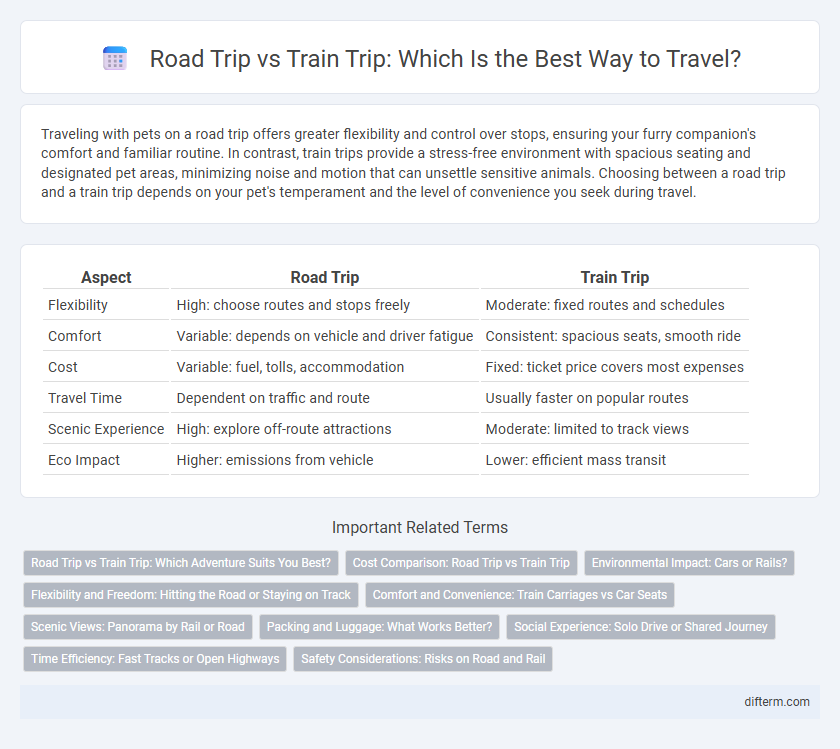Traveling with pets on a road trip offers greater flexibility and control over stops, ensuring your furry companion's comfort and familiar routine. In contrast, train trips provide a stress-free environment with spacious seating and designated pet areas, minimizing noise and motion that can unsettle sensitive animals. Choosing between a road trip and a train trip depends on your pet's temperament and the level of convenience you seek during travel.
Table of Comparison
| Aspect | Road Trip | Train Trip |
|---|---|---|
| Flexibility | High: choose routes and stops freely | Moderate: fixed routes and schedules |
| Comfort | Variable: depends on vehicle and driver fatigue | Consistent: spacious seats, smooth ride |
| Cost | Variable: fuel, tolls, accommodation | Fixed: ticket price covers most expenses |
| Travel Time | Dependent on traffic and route | Usually faster on popular routes |
| Scenic Experience | High: explore off-route attractions | Moderate: limited to track views |
| Eco Impact | Higher: emissions from vehicle | Lower: efficient mass transit |
Road Trip vs Train Trip: Which Adventure Suits You Best?
Road trips offer unparalleled flexibility, allowing travelers to customize routes, explore hidden gems, and control departure times, making them ideal for spontaneous adventurers seeking scenic drives and local culture. Train trips provide comfort, relaxation, and panoramic views without the stress of driving, perfect for those who prefer a leisurely journey with amenities like dining cars and Wi-Fi. Choosing between a road trip and a train trip depends on your priorities--whether it's independence and exploration or convenience and scenic tranquility.
Cost Comparison: Road Trip vs Train Trip
Road trips often incur higher costs due to fuel, tolls, and vehicle maintenance, especially over long distances, while train trips typically offer fixed ticket prices that can be more economical for solo travelers. Group travel may reduce per-person expenses in a car but train discounts and passes provide consistent savings without additional fees. Evaluating factors like fuel efficiency, train route availability, and ticket promotions is essential to determine the most cost-effective travel option between destinations.
Environmental Impact: Cars or Rails?
Road trips generally produce higher carbon emissions per passenger compared to train travel, making trains a more environmentally friendly option. Trains, especially electric-powered ones, have a lower carbon footprint due to efficient energy use and the ability to carry many passengers simultaneously. Choosing rail travel over driving reduces greenhouse gas emissions and helps minimize air pollution on long-distance journeys.
Flexibility and Freedom: Hitting the Road or Staying on Track
Road trips offer unmatched flexibility, allowing travelers to customize routes, make spontaneous stops, and explore off-the-beaten-path destinations. Train trips provide a fixed schedule and predetermined routes, which limit detours but ensure reliable timing and stress-free navigation. Choosing a road trip maximizes freedom and adaptability, while train travel prioritizes convenience and predictability.
Comfort and Convenience: Train Carriages vs Car Seats
Train carriages offer spacious seating with ample legroom and the ability to move freely, enhancing overall comfort during long journeys. Car seats in road trips often lack the space and ergonomic support found on trains, leading to potential discomfort over extended periods. Train travel provides convenient access to onboard facilities such as restrooms and dining cars, making it a more comfortable choice compared to the confined space and limited amenities of a car interior.
Scenic Views: Panorama by Rail or Road
Traveling by train offers uninterrupted panoramic views of landscapes rarely seen from highways, with large windows framing rolling hills, rivers, and quaint villages. Road trips provide flexibility to stop and explore scenic spots intimately, allowing travelers to experience hidden viewpoints, winding coastal roads, and lush forests at their own pace. Both modes capture distinct perspectives: rail journeys emphasize continuous, immersive vistas, while road trips highlight personalized exploration of diverse terrains.
Packing and Luggage: What Works Better?
Road trips offer greater flexibility for packing, allowing travelers to transport larger and heavier luggage without strict size or weight limits, ideal for carrying outdoor gear or bulky items. Train trips often impose luggage size and weight restrictions, requiring more strategic packing with compact, lightweight bags and essentials. Efficient packing for trains emphasizes organization and accessibility, while road trips prioritize convenience and volume capacity.
Social Experience: Solo Drive or Shared Journey
Road trips offer solo drivers complete control over the itinerary and solitude, fostering personal reflection and individual exploration. Train trips create opportunities for shared social experiences, enabling travelers to connect with fellow passengers and enjoy communal interactions in a relaxed environment. Choosing between these options depends on the preference for solitary adventure versus dynamic social engagement during travel.
Time Efficiency: Fast Tracks or Open Highways
Road trips offer flexible schedules and scenic detours, allowing travelers to control departure times and explore diverse attractions at their own pace. Train trips often provide faster city-to-city connections without traffic delays, maximizing productive or restful time during transit. Choosing between highways and fast tracks depends on prioritizing personalized experiences or streamlined travel efficiency.
Safety Considerations: Risks on Road and Rail
Road trips pose higher risks due to traffic accidents, driver fatigue, and variable weather conditions, with the National Highway Traffic Safety Administration reporting over 38,000 fatalities annually in the U.S. In contrast, train travel maintains a strong safety record, with the Federal Railroad Administration noting significantly fewer accidents and fatalities per passenger mile. Passengers considering safety should weigh the increased control and flexibility of road travel against the statistically safer, regulated environment of rail networks.
road trip vs train trip Infographic

 difterm.com
difterm.com